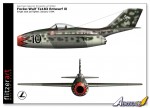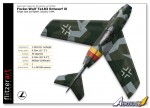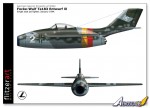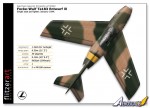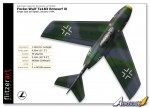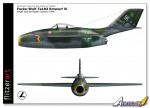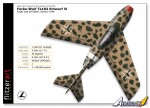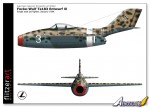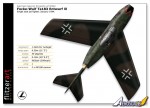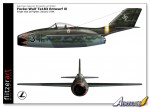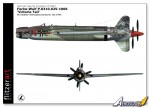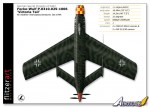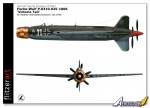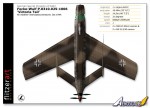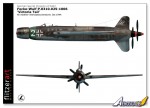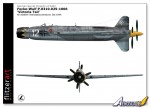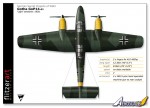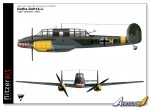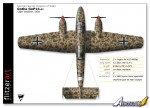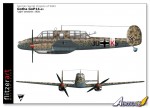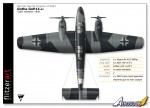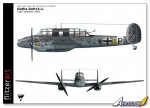German Secret Projects of WW2 Vol. 6
2
Comments
Focke Wulf Ta183 Entwurf lll Single jet fighter
In addition to the better known Ta183 Design ll, Multhopp's team also seriously explored a second version of the basic design, known as Design III, (a modified Design II). It is unknown what Design I referred to.It was similar to the Ta 183 Design ll, except the wings were swept back at 35 degrees and the cockpit was positioned further aft. The tail unit was of a more conventional design, with a curvilinear sweep of the fuselage into the vertical tail and the horizontal tail planes were mounted lower than the first design. There were two versions of the Design III, one in which the tail curved into the fuselage (as on profiles) and another where the tail unit faired straight into the fuselage. The latter tail unit was meant to be interchanged with the Design II tail unit for comparison tests. Armament consisted of two MK 108 30mm cannon located in the top, forward fuselage.
Focke Wulf P251 Entwurf lV Night fighter
Focke Wulf produced many similar designs under the P251 designation, all with the aim of finding the ideal compromise between weight, power and endurance to meet the RLM requirements for a advanced night and all weather fighter.The design V used a three engines and followed construction metods similar to the previous Vl design. Two engines were housed directly under the nose/cockpit with the third mounted in the tail being fed by intakes on the fuselage sides and boundary layer suction.To increase endurance, at least one engine could be shut down.
Although none of the P251 designs quite met the requirements and had numerous deficiencies they had a noticeable influence on immediate post-war Soviet aircraft design. Both the 1949 Lavochkin La-200 nightfighter and MiG I-320 all weather fighter bore some marked similarities. Work on both of these ceased when the Yakolev Yak-25 ‘Flashlight’ was selected for nocturnal defence.
Focke Wulf (P0310.025-1006) Victoria Tail Interceptor
Focke Wulf penned this single seat pusher propeller driven design in Sept/Oct 1944 as their high altitude all weather fighter entry.The power plant was to be one Argus 413 liquid-cooled 24-cylinder H-engine that would produce take-off power of 2984 kw (4000 hp) using two 3.1m (10ft 2in) diameter counter-rotating propellers driven via an extension shaft. The plane was to have a fuel capacity of 600 litres, giving it an estimated flight duration of 2 hours at 10,000m (33,000 feet).
Armament was to consist of two MK 103 30mm cannons and two MG 213/30 30mm cannons.
The most prominent feature was the ‘Victoria Tail’ aerodynamic configuration with wings of 31 degree back sweep, extended ribs that supported forward swept horizontal tail surfaces. This wing/tail arrangement not only promised an extremely strong structure, it also offered an appreciable drag reduction therefore enhancing aerodynamic efficiency.
The design also included a prominent annular radiator mounted on the extreme nose, which was regarded as one of the most efficient cooling solutions. The actual position of the nose wheel and it’s housing together with armament positions are unconfirmed.
Gotha P14 Light Zerstorer
As early as 1938 the Gothaer Waggonfabrik submitted 3 designs by Dipl-Ing Egwin Leiber for a ‘light zerstorer’. The reasoning behind these ‘light’ zerstorers was that they would, in theory, have been more than adequate for home and regional defence against, what was then, the opposition’s inferior aircraft. The RLM rejected all of them.However much later in the war, this idea was explored further in the form of the ‘Nahkampfflugzeuge’ (close combat aircraft). i.e. swarms of small, light aircraft getting in amongst enemy bomber formations.
Profile Notes: The P14 was one of the 3 designs originally submitted. Little exact data is available and the profiles here are based on the 3-view drawings that did survive the war.
Comments
Thanks for a great article Peter. I know how long these profiles take!
Incredible that the P1110 was designed 65 years ago, and yet wouldn't look out of place if it had been submitted alongside the YF-22 and YF-23.
MAY 15, 2010 - 11:10 AM
Many thanks Rowan, Jean-Luc and back room staff for doing the hard work in getting it up and running.
Thanks Ben.
In many cases I think the designs were so far advanced there was little chance of making them work then. The situation was one of needing technology to catch up to make a success of them which is possibly why so many look bang up to date even today in many respects.
More in the prep shop.
Peter
MAY 16, 2010 - 07:33 AM
Copyright ©2021 by Peter Allen. Images also by copyright holder unless otherwise noted. The views and opinions expressed herein are solely the views and opinions of the authors and/or contributors to this Web site and do not necessarily represent the views and/or opinions of AeroScale, KitMaker Network, or Silver Star Enterrpises. Images also by copyright holder unless otherwise noted. Opinions expressed are those of the author(s) and not necessarily those of AeroScale. All rights reserved. Originally published on: 2010-05-15 00:00:00. Unique Reads: 23702





